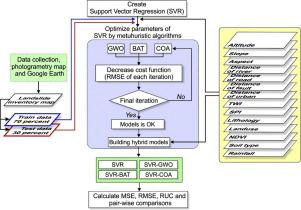Geoscience Frontiers ( IF 8.5 ) Pub Date : 2020-12-13 , DOI: 10.1016/j.gsf.2020.10.009 Abdul-Lateef Balogun , Fatemeh Rezaie , Quoc Bao Pham , Ljubomir Gigović , Siniša Drobnjak , Yusuf A. Aina , Mahdi Panahi , Shamsudeen Temitope Yekeen , Saro Lee

|
In this study, we developed multiple hybrid machine-learning models to address parameter optimization limitations and enhance the spatial prediction of landslide susceptibility models. We created a geographic information system database, and our analysis results were used to prepare a landslide inventory map containing 359 landslide events identified from Google Earth, aerial photographs, and other validated sources. A support vector regression (SVR) machine-learning model was used to divide the landslide inventory into training (70%) and testing (30%) datasets. The landslide susceptibility map was produced using 14 causative factors. We applied the established gray wolf optimization (GWO) algorithm, bat algorithm (BA), and cuckoo optimization algorithm (COA) to fine-tune the parameters of the SVR model to improve its predictive accuracy. The resultant hybrid models, SVR-GWO, SVR-BA, and SVR-COA, were validated in terms of the area under curve (AUC) and root mean square error (RMSE). The AUC values for the SVR-GWO (0.733), SVR-BA (0.724), and SVR-COA (0.738) models indicate their good prediction rates for landslide susceptibility modeling. SVR-COA had the greatest accuracy, with an RMSE of 0.21687, and SVR-BA had the least accuracy, with an RMSE of 0.23046. The three optimized hybrid models outperformed the SVR model (AUC = 0.704, RMSE = 0.26689), confirming the ability of metaheuristic algorithms to improve model performance.
中文翻译:

使用GWO,BAT和COA算法的混合支持向量回归(SVR)对塞尔维亚西部滑坡敏感性进行空间预测
在这项研究中,我们开发了多种混合机器学习模型来解决参数优化的局限性,并增强滑坡敏感性模型的空间预测。我们创建了一个地理信息系统数据库,我们的分析结果用于准备一份滑坡清单地图,其中包含从Google Earth,航空照片和其他经过验证的来源中识别出的359个滑坡事件。支持向量回归(SVR)机器学习模型用于将滑坡清单划分为训练(70%)和测试(30%)数据集。滑坡敏感性图是使用14个因果关系绘制的。我们应用已建立的灰狼优化(GWO)算法,蝙蝠算法(BA)和布谷鸟优化算法(COA)来微调SVR模型的参数,以提高其预测准确性。根据曲线下面积(AUC)和均方根误差(RMSE)验证了所得的混合模型SVR-GWO,SVR-BA和SVR-COA。SVR-GWO(0.733),SVR-BA(0.724)和SVR-COA(0.738)模型的AUC值表明了它们对滑坡敏感性模型的良好预测率。SVR-COA的精度最高,RMSE为0.21687,SVR-BA的精度最低,RMSE为0.23046。这三个优化的混合模型优于SVR模型(AUC = 0.704,RMSE = 0.26689),证实了元启发式算法改善模型性能的能力。738)模型表明了其对滑坡敏感性模型的良好预测率。SVR-COA的精度最高,RMSE为0.21687,SVR-BA的精度最低,RMSE为0.23046。这三个优化的混合模型优于SVR模型(AUC = 0.704,RMSE = 0.26689),证实了元启发式算法改善模型性能的能力。738)模型表明了其对滑坡敏感性模型的良好预测率。SVR-COA的精度最高,RMSE为0.21687,SVR-BA的精度最低,RMSE为0.23046。这三个优化的混合模型优于SVR模型(AUC = 0.704,RMSE = 0.26689),证实了元启发式算法改善模型性能的能力。











































 京公网安备 11010802027423号
京公网安备 11010802027423号